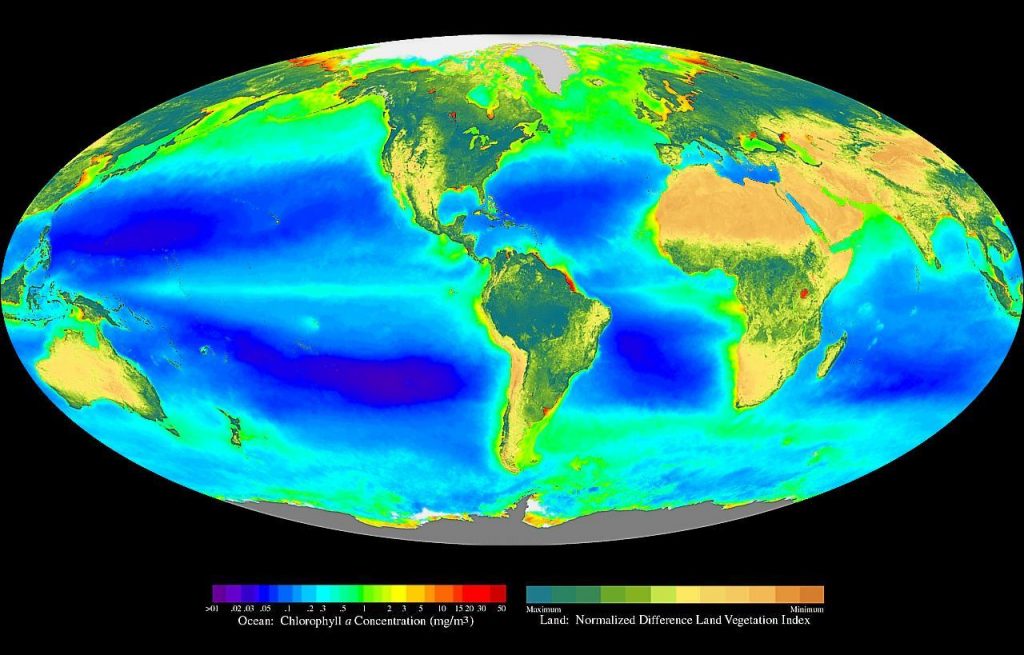7.4 Patterns of Primary Production
Primary productivity varies both geographically and seasonally. Geographically, phytoplankton abundance generally decreases as you move from coastal to oceanic waters (Figure 7.4.1). Coastal waters are more productive than the central ocean for two main reasons. First, runoff from land often contains a high abundance of nutrients which get deposited in coastal waters and stimulate production. Second, the shallower bottom along the continental shelf can trap nutrients and prevent them from sinking to greater depths. It is easier for these nutrients to be brought back to the surface when they remain trapped in the shallows. Conversely, the central ocean generally has very low primary production, as these areas are far removed from any terrestrial sources of nutrients, and the great depth prevents the deep nutrients from returning to the surface.
Global averages for ocean surface primary production are about 75-150 g C/m2/yr. Some highly productive areas include the California coast (200-300 g C/m2/year), the Southern Ocean (200-400 g C/m2/year), and the coast of Peru (200-400 g C/m2/year), all regions with significant upwelling. The central ocean, by contrast, produces less than 50 g C/m2/year.

Regional and seasonal changes in primary production are due to a combination of the availability of light and the amount of nutrients provided by water mixing above the thermocline. In tropical regions sunlight is plentiful throughout the year, so light is not a limiting factor. The surface water is always warm and there is always a pronounced thermocline, leading to highly stratified water that prevents the nutrient-rich bottom water from reaching the surface (section 6.2). Thus productivity in tropical water is always nutrient-limited, and productivity is low throughout the year (Figure 7.4.2). Because tropical water is nutrient-poor with little phytoplankton production, the water is very clear, as is the case with water in the central ocean.
At the poles, the water is uniformly cold at all depths, so there is not much of a thermocline and little stratification, allowing mixing to occur year-round (section 6.2). This mixing distributes nutrients throughout the water column, so that for much of the year productivity will not be nutrient-limited. However, the polar regions may experience several months with little or no light during the winter, and the fluctuation in light levels leads to variation is seasonal productivity. In the winter months, mixing is occurring and nutrients are abundant, but there is no light, so there is no productivity. By late spring the sunlight returns, and combined with the abundance of nutrients, a spring/summer bloom of phytoplankton occurs (Figure 7.4.2). By late summer, the nutrients have been depleted and zooplankton have been grazing on the phytoplankton, so the bloom begins to decline. In the autumn, light levels decline and prevent further production throughout the winter. But during the winter the mixing is distributing nutrients throughout the water, ready for the sun to return and stimulate a bloom in the following summer.
In temperate regions there is much more seasonal variation in the depth and intensity of the thermocline (see section 6.2). The thermocline is shallower and stronger in the summer, and is deeper and weaker in the winter, so mixing of deep and surface water is more pronounced in the winter months. As with the poles, this winter mixing creates nutrient-rich water during the winter, but the lack of light limits winter productivity. When light levels increase in the spring, the combination of abundant light and nutrients creates a spring bloom of productivity. By late summer there is still plenty of light, but the nutrients have been depleted by the phytoplankton bloom, and the summer thermocline has prevented further mixing, so productivity declines. In the autumn, cooler temperatures weaken the thermocline, and increasing storms cause a deeper mixed layer to form, bringing nutrients back to the surface. At the same time, there is still sufficient light available that a smaller autumn bloom occurs (Figure 7.4.2). But this bloom is short-lived, as light declines throughout the autumn and into the winter. Again, there is little production during the winter due to light limitations, but the winter storms and deep thermocline recharge the water with nutrients for the next spring bloom.

the synthesis of organic compounds from aqueous carbon dioxide by plants, algae, and bacteria (7.1)
drifting, usually single-celled algae that undergo photosynthesis (7.1)
flow of water down a slope, either across the ground surface, or within a series of channels (12.2)
in the context of primary production, substances required by photosynthetic organisms to undergo growth and reproduction (5.6)
the shallow (typically less than 200 m) and flat sub-marine extension of a continent (1.2)
process by which deeper water is brought to the surface (9.5)
a region in the water column where there is a dramatic change in temperature over a small change in depth (6.2)
small, drifting carnivorous organisms (7.1)
the topmost layer of the ocean, where winds, waves, and currents mix the water so that conditions are relatively constant; approximately the top 100 m (5.3)

